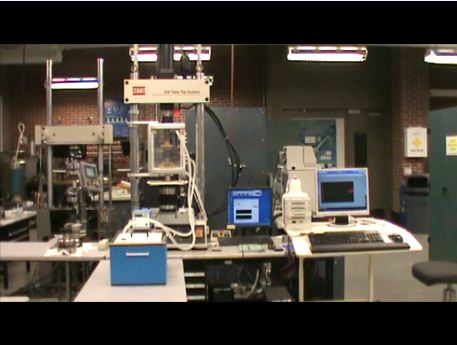Integrated Computational Materials Engineering (ICME)
Corrosion Fatigue Behavior of Extruded AM30 Magnesium Alloy
Introduction
Magnesium has become a competitive structural material in the automotive, aerospace and other industries. Magnesium alloys has the potential to replace steel components, because it has a better stiffness-to-weight ratio and strength-to-weight ratio. However, despite magnesium alloys’ competitive mechanical properties, its high chemical activity leads to poor corrosion resistance when exposed to an external environment.[1][2] Since many structural parts are often subjected to pro-longed cyclic stresses in an active medium; it is of significant scientific and practical importance to characterize the corrosion fatigue behavior of Mg alloys. At Center for Advanced Vehicular Systems, the macroscale corrosion fatigue experiments were conducted in the ambient environment and 3.5% NaCl solution, respectively. The drastic reduction in fatigue life under the corrosive environments was resulted from pit formation and growth to the critical size for fatigue crack nucleation.
Method
The fatigue experiments implemented a 25 KN servo-hydraulic MTS 858 load frame. MTS 858 was equipped with a 10 L environment chamber to hold the salt water, and also applied a pump to refresh the salt water in the chamber. Fatigue tests were conducted in two environments, one was the lab air environment (temperature 23°C, relative humidity 45%-50%), the other is salt water environment (3.5% NaCl solution, temperature 23°C). Fatigue specimens were tested to failure (50% load drop) along the extrusion direction under load control condition, with stress ratio equals 0.0, frequency of 5 Hz. The fatigue tests were stopped if the specimen did not break at 106 cycles, and regarded this stress level as the endurance limit for AM30.

Figure 1: Corrosion fatigue experiment set-up.
Results
Checking the stress amplitude and fatigue life data, fatigue life in the ambient environment was higher than the fatigue life in the corrosive environment. When observing the fracture surface of the specimen tested in both environment, the fracture surface in the NaCl solution is rougher than the in the air ones, this is attributed to the hydrogen embrittlement, which reduces the material resistance and metallic bonding strength along grain boundary, can caused the integranular fracture surface. In addition, the crack nucleation in the air environment is mainly caused by the debonding of the inclusion particle, or the deformation resulted from tremendous amount of twining. For the corrosive environment, pits generated in the corrosion fatigue process can act as stress concentrators and prematurely nucleate the fatigue cracking. The fatigue crack will initiate from the corrosion pit either when the stress intensity factor around the corrosion pit reaches the threshold for fatigue cracking[3].
References
1. Cheng, Y.I., Qin, T.W., Wang, H.M., Zhang, Z., Comparison of corrosion
behaviors of AZ31, AZ91, AM60, and ZK60 magnesium alloys, Trans. Nonferrous
Met. Soc. China, 19 (2009) 517-524
2. Zhao, M.C., Schmutz, P., Brunner, S., Liu, M., Song, G.L., Atrens, A., An
exploratory study of the corrosion of Mg alloys during interrupted salt spray
testing, Corros. Sci. 51(2009) 1277-1292
3. Kondo, Y., Prediction of Fatigue Crack Initiation Life Based on Pit Growth.
Corrosion: January Vol. 45(1989), pp. 7-11.
